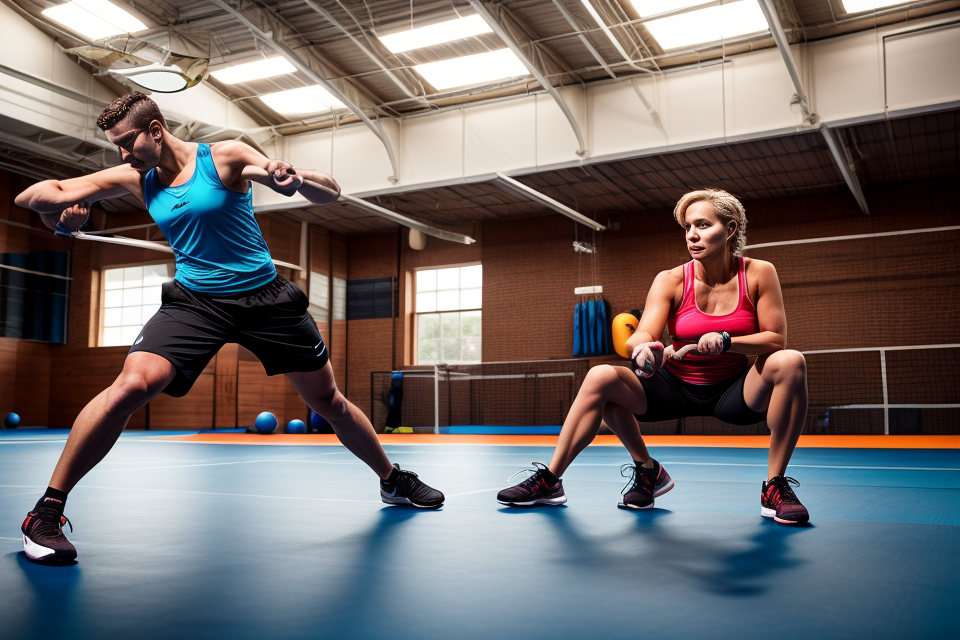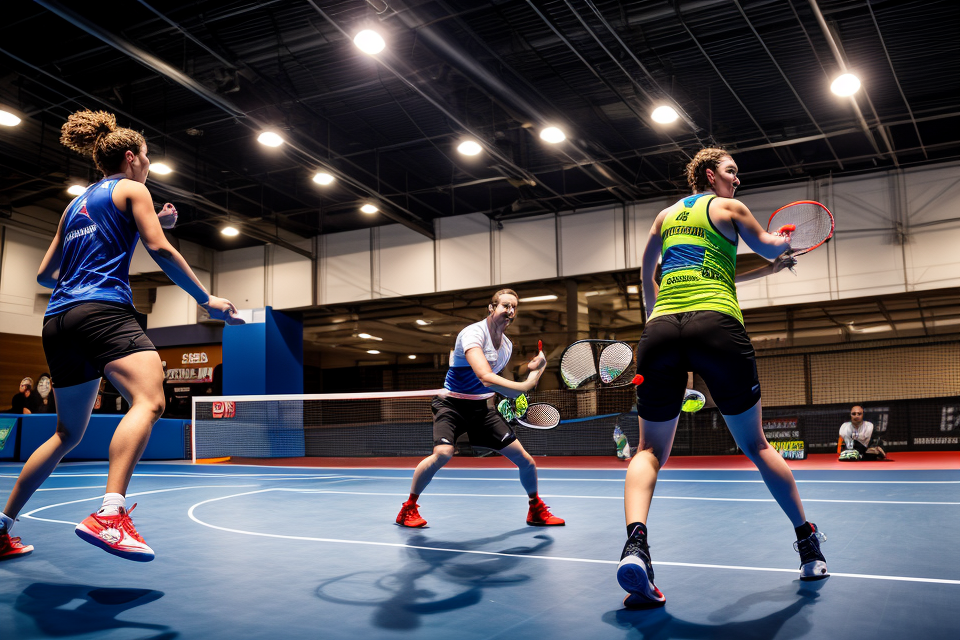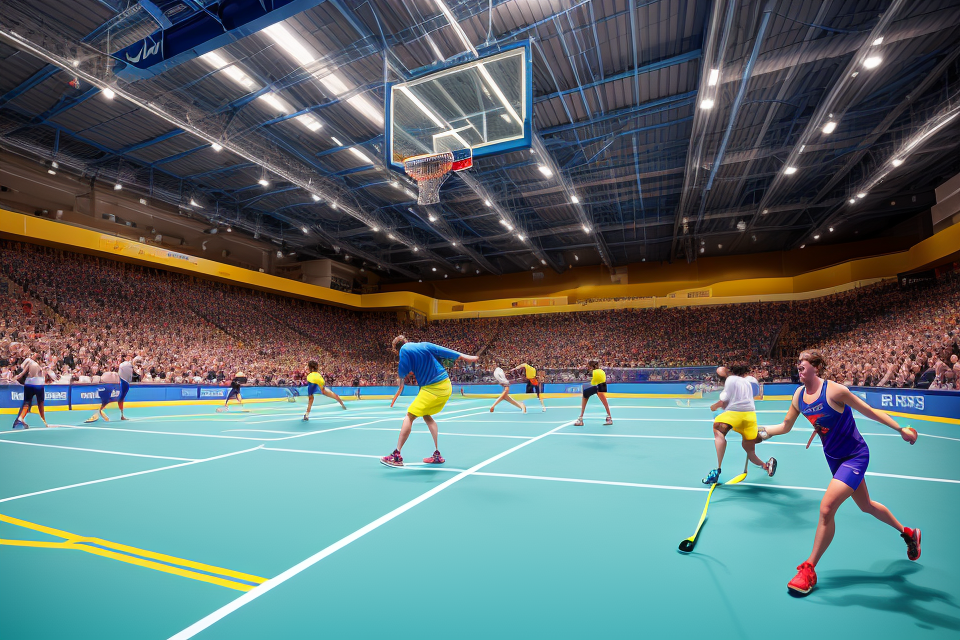Squash is a physically demanding sport that requires a combination of strength, endurance, and agility. Whether you’re a beginner or an experienced player, improving your squash fitness is essential to achieving success on the court. In this comprehensive guide, we’ll explore various ways to enhance your physical conditioning, including exercises, drills, and nutrition tips. From improving your footwork and agility to building strength and endurance, this guide has everything you need to take your squash game to the next level. So, get ready to elevate your fitness and dominate the squash court!
To improve your squash fitness, it is important to focus on developing your cardiovascular endurance, strength, and agility. This can be achieved through a combination of physical training, such as weightlifting and interval training, and on-court drills that target the specific movements used in squash, such as lunges and jumps. Additionally, it is important to practice proper technique and form, as well as to stay hydrated and recover properly between games and matches. Finally, it is essential to maintain a healthy diet and to get enough rest in order to support your overall fitness and performance.
Understanding Squash Fitness
The Importance of Fitness in Squash
Cardiovascular Endurance
In squash, cardiovascular endurance is essential as it helps players maintain a high level of intensity throughout the game. Players need to be able to move quickly and efficiently around the court, and this requires a strong cardiovascular system. Cardiovascular endurance can be improved through regular cardiovascular exercise such as running, cycling, or swimming.
Strength and Power
Strength and power are crucial in squash as they help players to hit the ball with more force and control. Players need to have strong muscles in their legs, arms, and core to generate power and maintain balance and stability on the court. Strength and power can be improved through strength training exercises such as weightlifting, resistance bands, and bodyweight exercises.
Flexibility and Mobility
Flexibility and mobility are also important in squash as they allow players to move freely and easily around the court. Players need to have a good range of motion in their joints and muscles to be able to make quick and precise movements. Flexibility and mobility can be improved through stretching and mobility exercises such as yoga and Pilates.
It is important to note that improving fitness in squash requires a well-rounded approach that includes all of these components. Players should aim to incorporate a combination of cardiovascular exercise, strength training, and flexibility and mobility exercises into their training regimen to achieve optimal performance on the court.
The Benefits of Improved Fitness in Squash
Improving your fitness level in squash can have a multitude of benefits for your performance on the court. These benefits can be broken down into three main categories:
Increased Performance
As you improve your fitness level, you will notice that you are able to perform at a higher level during matches. This is because your body is better able to withstand the physical demands of the sport, allowing you to move more quickly and efficiently. Additionally, improved cardiovascular endurance will enable you to sustain high-intensity effort for longer periods of time, giving you an edge over your opponents.
Reduced Risk of Injury
Improved fitness can also help to reduce your risk of injury while playing squash. By building strength and flexibility in your muscles, you will be better able to absorb the impact of hits and reduce the risk of strains and sprains. Additionally, having a strong core can help to stabilize your spine and reduce the risk of back injuries.
Improved Longevity in the Sport
Finally, improved fitness can help to improve your longevity in the sport. By maintaining a high level of physical fitness, you will be able to continue playing squash at a high level for longer periods of time. This can help to prolong your career and keep you competitive even as you age.
Overall, the benefits of improved fitness in squash are numerous and can have a significant impact on your performance on the court. Whether you are a beginner or an experienced player, making a commitment to improving your fitness level can help you to reach your full potential in the sport.
Assessing Your Current Fitness Level
Physical Assessments for Squash Fitness
To improve your squash fitness, it is essential to first assess your current fitness level. This can be done through physical assessments that specifically target the skills and attributes required for squash. Here are some physical assessments that can help you gauge your current fitness level for squash:
Basic Fitness Tests
Before beginning any sport-specific training, it is important to ensure that you have a basic level of fitness. Some basic fitness tests that can be done to assess your overall fitness level include:
- Cardiovascular endurance test: This test involves running or cycling for a set distance or time, with the aim of measuring your cardiovascular endurance. A simple way to measure this is by running a mile and timing yourself.
- Strength and power tests: These tests measure your muscular strength and power, which are important for squash. Examples of strength and power tests include push-ups, pull-ups, and jump squats.
- Flexibility and mobility tests: These tests measure your range of motion and flexibility, which are important for avoiding injury and maintaining proper form in squash. Examples of flexibility and mobility tests include the sit and reach test and the shoulder flexibility test.
Specific Squash Drills and Tests
Once you have established a basic level of fitness, you can move on to more specific squash drills and tests. These drills and tests will help you assess your skills and attributes that are specific to squash, such as your agility, speed, and endurance. Some specific squash drills and tests include:
- Agility drills: These drills measure your ability to move quickly and change direction, which are essential skills for squash. Examples of agility drills include shuffle drills and ladder drills.
- Endurance drills: These drills measure your ability to sustain high-intensity activity for an extended period, which is important for squash matches that can last up to an hour or more. Examples of endurance drills include interval training and circuit training.
- Speed drills: These drills measure your ability to move quickly, which is important for getting to the ball and returning it with power. Examples of speed drills include sprint drills and plyometric drills.
By conducting these physical assessments, you can identify your strengths and weaknesses and tailor your training program to meet your specific needs.
Identifying Weaknesses and Setting Goals
Analyzing Results
To begin, it is essential to analyze your current fitness level by performing a fitness assessment. This assessment should include measurements of your strength, endurance, and flexibility. You can conduct this assessment by visiting a gym or fitness center, where a trained professional can assist you in performing various exercises and measuring your results.
Alternatively, you can perform a self-assessment by using fitness tests such as the beep test, sit and reach test, and push-up test. These tests will help you identify your strengths and weaknesses, which will guide you in setting specific and measurable goals.
Setting SMART Goals
Once you have identified your weaknesses, it is crucial to set specific, measurable, achievable, relevant, and time-bound (SMART) goals. These goals should be tailored to your individual needs and take into account your current fitness level, available resources, and personal circumstances.
For example, if you find that your endurance is lacking, a SMART goal could be to increase your running time by 20% within the next three months. Alternatively, if you are looking to improve your strength, a SMART goal could be to increase your bench press by 10kg within the next six months.
It is important to remember that setting goals is only the first step. To achieve your goals, you must also develop a comprehensive training program that addresses your weaknesses and builds on your strengths. This program should include a variety of exercises, such as strength training, cardiovascular exercise, and flexibility training, all of which will help you improve your overall fitness level and enhance your performance on the squash court.
Developing a Training Program
Periodization and Program Design
Effective periodization and program design are essential components of a comprehensive training program for squash players. Periodization refers to the systematic organization of training sessions to optimize athletic performance and prevent injury. Program design involves creating a tailored training plan that incorporates various training modalities, including resistance training, cardiovascular training, and flexibility and mobility training.
In periodization, athletes typically follow a cycle of training phases, including endurance, strength, power, and peaking. The endurance phase focuses on building a solid foundation of cardiovascular fitness and improving muscular endurance. The strength phase aims to increase muscular strength and power, while the power phase emphasizes developing explosiveness and quickness. Finally, the peaking phase involves tapering down training to optimize performance during competitions.
A well-designed program should also take into account the specific needs of the individual player. For instance, players with a higher body mass index (BMI) may benefit from more resistance training to improve their muscle-to-fat ratio, while players with a lower BMI may need to focus more on endurance training to build up their energy systems.
It is important to note that periodization and program design should be tailored to the individual player’s level of experience, goals, and current fitness level. For instance, a beginner player may start with a simple program that focuses on building basic skills and gradually progress to more advanced training as they improve.
Overall, a well-designed periodization and program design can help squash players optimize their performance and prevent injury. By incorporating a variety of training modalities and tailoring the program to the individual player’s needs, squash players can achieve their fitness goals and perform at their best on the court.
Periodization Examples for Squash Fitness
Block Periodization
Block periodization is a popular method used by many athletes to improve their fitness for squash. This method involves dividing the training year into multiple blocks, each focusing on different aspects of fitness. For example, a block might focus on developing endurance, while another block might focus on developing strength and power. The duration of each block can vary depending on the athlete’s goals and needs, but typically ranges from several weeks to several months.
One advantage of block periodization is that it allows athletes to focus on specific aspects of their fitness without being distracted by other training objectives. This can be particularly useful for athletes who are looking to improve their overall fitness for squash, as it allows them to target specific areas of weakness and make steady progress over time.
Linear Periodization
Linear periodization is another popular method used by athletes to improve their fitness for squash. This method involves gradually increasing the intensity and volume of training over time, with the goal of building up to a peak level of fitness at the end of the training cycle. Linear periodization typically follows a four-stage progression, with each stage focusing on a different aspect of fitness.
The first stage of linear periodization is the preparatory stage, which focuses on building a base level of fitness and reducing the risk of injury. The second stage is the competitive stage, which focuses on developing the specific skills and abilities needed for squash. The third stage is the intensification stage, which involves gradually increasing the intensity and volume of training to build up to a peak level of fitness. The final stage is the tapering stage, which involves reducing the volume and intensity of training in the days leading up to a competition to allow the athlete to perform at their best.
Undulating Periodization
Undulating periodization is a method that combines elements of both block and linear periodization. This method involves altering the intensity and volume of training on a weekly basis, with each week consisting of a different training focus. For example, one week might focus on developing endurance, while the next week might focus on developing strength and power.
One advantage of undulating periodization is that it allows athletes to incorporate a variety of training objectives into their program without sacrificing the benefits of either block or linear periodization. This can be particularly useful for athletes who are looking to improve their overall fitness for squash, as it allows them to target multiple areas of weakness at once and make steady progress over time.
Incorporating Squash-Specific Drills and Exercises
Technical and Tactical Drills
Squash is a game that requires technical skill and tactical knowledge. To improve your fitness for squash, it is important to incorporate technical and tactical drills into your training program. These drills can help you develop the skills and strategies needed to excel on the court.
Here are some examples of technical and tactical drills that you can include in your training program:
- Footwork drills: These drills can help you improve your speed, agility, and footwork on the court. Examples include ladder drills, cone drills, and shuttle runs.
- Stroke drills: These drills can help you improve your stroke technique and accuracy. Examples include forehand and backhand drives, volleys, and drop shots.
- Tactical drills: These drills can help you develop your strategic thinking and court awareness. Examples include positioning drills, where you practice moving to the right positions on the court, and reaction drills, where you practice reacting to your opponent’s shots.
Position-Specific Drills
In addition to technical and tactical drills, it is also important to include position-specific drills in your training program. These drills can help you develop the skills and techniques needed to excel in specific positions on the court.
For example, if you play in the front court, you may want to focus on your volley and drop shot skills. If you play in the back court, you may want to focus on your lob and drive skills. By incorporating position-specific drills into your training program, you can become a more well-rounded player and improve your overall fitness for squash.
Match Simulation Drills
Finally, it is important to include match simulation drills in your training program. These drills can help you prepare for the physical and mental demands of a real match.
Examples of match simulation drills include simulated match play, where you play a series of points against a partner or opponent, and endurance drills, where you practice playing for long periods of time without rest. By incorporating match simulation drills into your training program, you can improve your stamina, endurance, and mental toughness on the court.
Nutrition and Recovery for Optimal Performance
Fueling for Squash Matches
Proper nutrition is essential for squash players to maintain energy levels and support optimal performance during matches. The following are some key nutritional strategies for fueling for squash matches:
- Consume a balanced diet rich in carbohydrates, protein, and healthy fats to provide sustained energy and support muscle recovery.
- Hydrate adequately before, during, and after matches to prevent dehydration and maintain fluid balance.
- Include a source of complex carbohydrates, such as whole grains or legumes, as part of your pre-match meal to help fuel your body during the match.
- Opt for healthy snacks, such as fruit or a protein bar, to consume as energy during matches.
Hydration and Electrolyte Replacement
Adequate hydration is crucial for maintaining physical performance and preventing heat-related illnesses during squash matches. Players should aim to drink water regularly throughout the day, including before, during, and after matches.
Electrolytes, such as sodium, potassium, and calcium, play a critical role in maintaining fluid balance and muscle function. Sports drinks or electrolyte tablets can be used to supplement water intake and replace lost electrolytes during matches.
Post-Match Recovery Strategies
Recovery is essential for restoring energy stores, repairing muscles, and preventing injury. The following are some key post-match recovery strategies for squash players:
- Consume a carbohydrate-rich meal or snack within 30 minutes of finishing a match to replenish energy stores.
- Include protein in post-match meals or snacks to support muscle repair and growth.
- Hydrate adequately after matches to replace lost fluids and electrolytes.
- Allow for adequate rest and recovery time between matches, including stretching or foam rolling to reduce muscle soreness and improve flexibility.
Monitoring Progress and Adjusting the Plan
Tracking Performance Indicators
Time-Based Metrics
Time-based metrics are an essential component of tracking performance indicators in squash fitness. These metrics provide an objective measure of progress and help to set realistic goals. The most common time-based metrics include:
- Match time: This metric measures the duration of a match played. It is an excellent way to gauge endurance and stamina levels.
- Rest time: This metric measures the time taken to recover between games or sets. It helps to assess recovery time and endurance levels.
- Drill time: This metric measures the time spent on drills and practice sessions. It helps to gauge the efficiency of training sessions and progress towards achieving goals.
Distance-Based Metrics
Distance-based metrics are another set of indicators used to track progress in squash fitness. These metrics help to measure the distance covered during a match or training session. The most common distance-based metrics include:
- Court coverage: This metric measures the distance covered while playing a match. It helps to assess footwork, agility, and endurance levels.
- Sprint distance: This metric measures the distance covered while sprinting during a match. It helps to assess speed and power levels.
- Drill distance: This metric measures the distance covered during drills and practice sessions. It helps to gauge the efficiency of training sessions and progress towards achieving goals.
Skill-Based Metrics
Skill-based metrics are the final set of indicators used to track progress in squash fitness. These metrics help to measure the improvement in technical skills such as accuracy, precision, and control. The most common skill-based metrics include:
- Shot accuracy: This metric measures the percentage of shots that land in the desired area of the court. It helps to assess the improvement in shot placement and control.
- Ball control: This metric measures the ability to control the ball during play. It helps to assess the improvement in footwork, balance, and coordination.
- Movement efficiency: This metric measures the efficiency of movement during play. It helps to assess the improvement in agility, balance, and speed.
By tracking these performance indicators, you can gain a better understanding of your progress towards achieving your squash fitness goals. It is essential to track these metrics regularly and adjust your training plan accordingly to ensure continuous improvement.
Evaluating Progress and Making Adjustments
Periodic Assessments
Regular assessments of your progress are essential in determining the effectiveness of your training program. It is recommended to conduct these assessments every two to four weeks, depending on your fitness level and goals. This allows you to measure your improvement and make any necessary adjustments to your training plan.
Comparing Results to Goals
It is important to compare your results to your original goals. This will help you determine if you are on track to achieving your desired level of fitness. If you find that you are not making progress, it may be necessary to adjust your training program to increase the intensity or duration of your workouts.
Adjusting Training Programs Based on Results
Based on your periodic assessments and comparison to your goals, you may need to make adjustments to your training program. This may include increasing the intensity or duration of your workouts, adding new exercises or drills, or changing your overall approach to training. It is important to make these adjustments in a timely manner to ensure that you continue to progress towards your goals.
Additionally, it is important to listen to your body and adjust your training program accordingly. If you experience any pain or discomfort, it may be necessary to reduce the intensity or duration of your workouts to avoid injury. By regularly evaluating your progress and making adjustments to your training program, you can ensure that you are making the most of your time and effort in improving your squash fitness.
Continuous Improvement in Squash Fitness
Continuous improvement is a critical aspect of enhancing your squash fitness. It involves regularly monitoring your progress, assessing your performance, and making adjustments to your training program as necessary. This approach ensures that you stay on track towards achieving your long-term goals while also maintaining motivation and commitment to the process.
Long-Term Goal Setting
The first step in continuous improvement is setting long-term goals. These goals should be specific, measurable, achievable, relevant, and time-bound (SMART). Examples of long-term goals for squash fitness include increasing your endurance, improving your speed and agility, and enhancing your strength and power.
It’s essential to set realistic long-term goals that challenge you but are also attainable. Having clear long-term goals will help you stay focused and motivated as you progress through your training program.
Periodic Reassessment and Adjustment
Once you have set your long-term goals, it’s crucial to periodically reassess your progress and adjust your training program as necessary. This process involves tracking your performance, analyzing your strengths and weaknesses, and identifying areas that need improvement.
Reassessment can be done monthly or quarterly, depending on your progress and the complexity of your training program. During reassessment, you should evaluate your fitness level, skill development, and overall performance in squash.
Based on your reassessment results, you may need to adjust your training program to address any weaknesses or to challenge yourself further. For example, if you find that your endurance is improving but your speed and agility are not, you may need to focus more on drills that enhance these aspects of your game.
Staying Motivated and Committed to the Process
Continuous improvement in squash fitness requires a long-term commitment to the process. It’s essential to stay motivated and committed to your training program to achieve your long-term goals.
One way to stay motivated is to celebrate small wins and milestones along the way. Recognizing your progress, no matter how small, can help you stay focused and motivated to continue improving.
It’s also essential to stay committed to the process, even when you face setbacks or challenges. Setbacks are a natural part of the improvement process, and it’s important to learn from them and continue moving forward.
In conclusion, continuous improvement is a vital aspect of enhancing your squash fitness. By setting long-term goals, periodically reassessing your progress, and adjusting your training program as necessary, you can stay on track towards achieving your goals while also maintaining motivation and commitment to the process.
FAQs
1. What are the best exercises to improve my squash fitness?
Answer:
Improving your squash fitness requires a combination of physical and mental training. Some of the best exercises to improve your squash fitness include cardio exercises such as running, cycling, and swimming, as well as strength training exercises such as weightlifting and bodyweight exercises. Additionally, specific squash drills can help improve your technique and endurance on the court.
2. How often should I train to improve my squash fitness?
To see significant improvements in your squash fitness, it’s recommended to train at least three to four times per week. However, it’s important to allow for proper recovery time between workouts to avoid injury and maximize muscle growth.
3. What should I eat to improve my squash fitness?
Eating a balanced diet that includes plenty of protein, complex carbohydrates, and healthy fats is essential for improving your squash fitness. Additionally, staying hydrated by drinking plenty of water throughout the day can help improve your performance on the court.
4. How can I avoid injury while training for squash?
To avoid injury while training for squash, it’s important to warm up properly before each workout, stretch regularly, and incorporate strength training exercises to improve your muscle imbalances. Additionally, make sure to allow for proper recovery time between workouts and listen to your body to avoid overtraining.
5. How can I improve my mental game in squash?
Improving your mental game in squash involves developing focus, concentration, and mental toughness. Some ways to improve your mental game include visualization exercises, practicing positive self-talk, and learning how to manage your emotions on the court. Additionally, working with a sports psychologist or coach can provide additional guidance and support.










